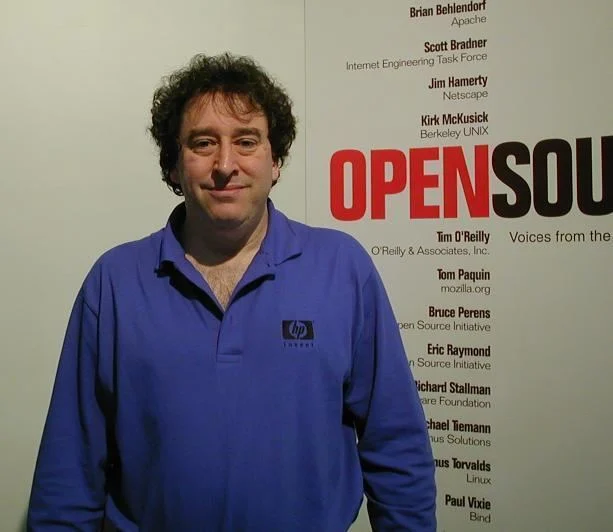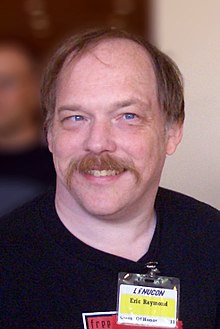The Cathedral and the Bazaar
Eric S. Raymond published "The Cathedral and the Bazaar: Musings on Linux and Open Source by an Accidental Revolutionary," initially as an essay at the Linux Kongress on May 27, 1997 in Würzburg (Germany), and later as a book on September 30, 1999. It described key differences between traditional development models and the decentralized model typical of open source, based on his observations of the Linux kernel development process and his experiences managing an open source project, fetchmail.

Netscape Open Sourced
In January 1998, Netscape Communications Corporation released the code for Netscape Communicator as open source, influenced by the Eric S. Raymond's essay "The Cathedral and the Bazaar," in the hopes that it would become a popular open- source project. Netscape placed the code under the Netscape Public License, which was similar to the GNU General Public License, and started the Mozilla project to coordinate its development.

Open Source Label
The "open source" label was created by Christine Peterson at a strategy session held on February 3rd, 1998 in Palo Alto, California, shortly after the announcement of the release of the Netscape source code. This group looked for a way to re-brand the free software movement to emphasize the business potential of the sharing of source code. Two of those present at the Palo Alto meeting (Eric Raymond and Michael Tiemann) would later serve as presidents of the OSI, and other attendees (including Todd Andersen, Jon “maddog” Hall, Larry Augustin, and Sam Ockman) became key early supporters of the organization.

Open Source Initiative
The Open Source Initiative (OSI) was founded in late February 1998 by Eric Raymond and Bruce Perens. The OSI hoped that the use of the label "open source" would eliminate ambiguity, particularly for individuals who perceive "free software" as anti-commercial. They sought to bring a higher profile to the practical benefits of freely available source code, and they wanted to bring major software businesses and other high-tech industries into open source. OSI was formed as an educational, advocacy, and stewardship nonprofit organization.

Open Source Definition
One of the first tasks undertaken by OSI was to draft the Open Source Definition (OSD), and use it to begin creating a list of OSI-approved licenses.
The Open Source Definition was originally derived from the Debian Free Software Guidelines (DFSG). Bruce Perens had composed the original draft of the DFSG, and it was edited, refined, and approved as formal policy by the Debian developer community in 1997.
The Open Source Definition was then created during the launch of the OSI in February 1998 by revising the DFSG and removing Debian-specific references.

Open Source Summit
The "open source" term was given a big boost at an event organized in April 1998 by technology publisher Tim O'Reilly. Originally titled the "Freeware Summit" and later named the "Open Source Summit", the event brought together the leaders of many of the most important free and open-source projects, including Linus Torvalds (Linux), Larry Wall (Perl), Brian Behlendorf (Apache), Eric Allman (Sendmail), Guido van Rossum (Python), Phil Zimmerman(Pretty Good Privacy), Michael Tiemann (Cygnus Solutions), Paul Vixie (Bind), Jamie Zawinski (Netscape), and Eric Raymond (Fetchmail).

Halloween Documents
As free and open software became more popular, industry incumbents such as Microsoft started to see it as a serious threat. This was shown in a leaked 1998 document by Eric S. Raymond, confirmed by Microsoft as genuine, which came to be called the first of the Halloween Documents. These documents acknowledged that free software products such as Linux were technologically competitive with some of Microsoft's products, and set out a strategy to combat them. It revealed that "FUD" (spreading Fear, Uncertainty, and Doubt) was a traditional Microsoft marketing strategy, acknowledged and understood internally. The document then suggests that this can be stopped by "extending these protocols and developing new protocols" and "de-commoditizing protocols & applications". This policy has been internally nicknamed "embrace, extend, extinguish". The document describes, among other points, Microsoft's channeling of $86 million to SCO.

OSI License Lists
OSI established the "License Discuss" and "License Review" mailing lists to discuss open source licenses, update existing licenses, and review new licenses submitted for certification.
Today these lists still exist, supporting the OSI License Review Process, with the goal of ensuring that licenses and software labeled as "open source" conforms to existing community norms and expectations. For that reason, all licenses submitted to the OSI for certification as must go through a public review process. The OSI Board consults with entities in advance to help them navigate the process and improve their license.
OSI Keyhole & Mark
In November of 1998, the OSI held a contest for "a logo which can be used to promote the concept of Open Source, and to indicate support of the Open Source movement." By June of 1999, the OSI selected the now iconic "Keyhole Logo" by Colin Viebrock.
Because the community also needed a reliable way of knowing whether a piece of software really is open source, the OSI registered a certification mark, "OSI Certified." When this mark is included with software, users can be assured the software carries a license that conforms to the Open Source Definition.

License Proliferation
The OSI tackles license proliferation to help developers choose an appropriate license for their project and make it easier for them to understand what they are agreeing to in a multi-license distribution. The OSI recommends licenses that are popular and widely used or with strong communities. Examples of popular licences include Apache, BSD, GPL, and MIT.
Fauxpen Source
In 2018, while the OSI was on its 20th Anniversary World Tour, some faux open source licenses started emerging, most notably the Commons Clause and the Server Side Public License. OSI and its partners, with the support from the open source community, were able to successfully organize over 100 activities across 40 events worldwide to celebrate its anniversary and defend the open source definition. At the end of the tour, several OSI affiliates signed the Affirmation of the Open Source Definition.